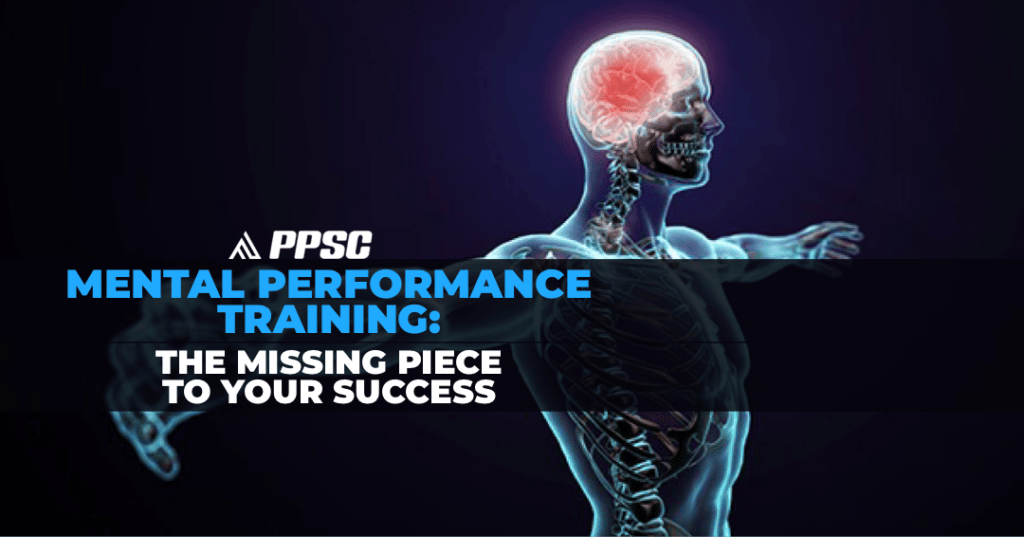Mental Performance Training: The Missing Piece to your Success
As coaches, trainers, and other fitness professionals we spend countless hours trying come up with the ideal game and strive to perfect the art of program design via exercise selection, appropriate intensity levels, movement strategy, various reps and sets schemes, ways to periodize and progress the physical side of our clients and athletes.
Constructing a solid game plan for the physical part of fitness and health achievement is no doubt a crucial and necessary aspect of every individual training programing, but to be honest, its only HALF of the SOLUTION to achieving ultimate success.

The other half requires diving a little deeper and exploring what is often uncharted territory for trainers, training the MENTAL game.
We (the Fit Pros) have an opportunity to not only add value to our services but help accelerate our client’s success by providing them with strategies to really take them to the next level, tap further into their highest potential in sport, performance, and day to day operations.
Regular training of the ‘Mental Game’ with mindset strategies can help prepare the mind for roadblocks and help us rebound quicker from mental mistakes.
TRAINING THE MENTAL GAME FOR PERFORMANCE AND EVERYDAY LIFE
Mental barriers have been shown to influence and impact our behavior making and game day performance either helping us with a successful outcome or negatively impact our performance leaving us mentally beat, emotionally flustered, and physically exhausted.
Often time when we give something are all (giving up social events and delicious food to achieve our desired outcomes) and don’t see or feel like we are getting closer to our goals often comes from one major missing piece to the puzzle, MENTAL PERFORMANCE TRAINING (MPT).

This alone more likely is the missing piece that is needed to help break through plateaus, rebound if mistakes are made, and ultimately will lead you to the best version of yourself and provide you with a path to success and the desired outcome you are after.
Afterall, it is 90% mental. Everything we do starts in our mind. We must first think about it then act about it, making those barriers, set-backs, sabotage, failures, and frustrations all coming from a place that is not regularly trained and maintained.
Just like we do with our physical health, our mental health should be a focal point of any training program. Paying respect to the way we see and perceive ourselves, our successes’, our goals, and our destinations will only OPTIMIZE your health goals and physical outcome.
When it comes to athletic performance or fitness pursuits the common struggle is not poor training quality, lack of skill acquisition, or inadequate coaching and programming.
When the lights come on, cameras are rolling, the heat of competition is turned up and it’s time to show up and perform your best and then you don’t, or the team falls apart and the game plan is not executed as planned.

The problem is the pressure, the nerves, the lack of confidence, poor focus, negative self-talk, and inner performance critic getting the best of us.
Often expressed by athletes/clients is that they doubt their abilities, fear failing and upsetting their coaches, teammates, or families.
They will freeze under pressure, become forgetful and stressed, or under perform in response to negative feedback from their coach, teammates, or their competition pushing them into a self-criticizing hole that can be hard to get out of.
These are common mental mistakes experienced by fitness populations.
Mental Performance Training is the key to dig yourself out of whatever dark place you found yourself in. Overcoming the barriers to your physical performance success will be a result of your ability to establish and maintain emotional and mental momentum toward the realization of your personal vision.
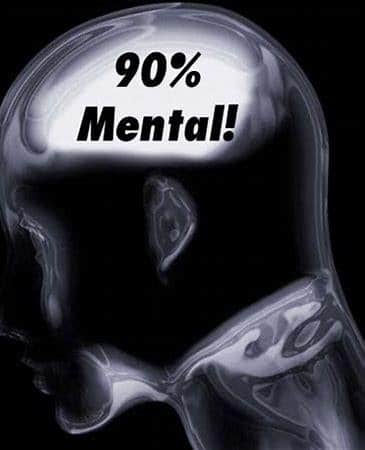
MPT is exactly why some people thrive under pressure while other people crumble. Some people reach their full potential while others never get close. Some people bounce back quickly after a mistake or poor performance while others sink into a self-critical state.
The difference is mental preparation and mental toughness. Things that improve via TRAINING STRATEGIES. Below are 5 Mental Training techniques supportive of consistent high performance.
STRATEGY #1: ZONES and Self-Awareness
I use this strategy to assist my clients in becoming more self-aware, as it’s a journey unto itself. The first step to change is becoming aware and knowing change is needed. Without its self-awareness we cannot make necessary changes.
Finding out what ‘Zone’ our clients and athletes are in will allow us as coaches to identify areas of opportunity for the person we are working with. I use this at the start of every week or even every training session.
Simply outlining 3 zone categories, Green, Yellow, and Red Zones to see where they are mentally at in this given time.
The more information we have the better suited we will be as coaches to help our clients navigate what could easily be holding them back.
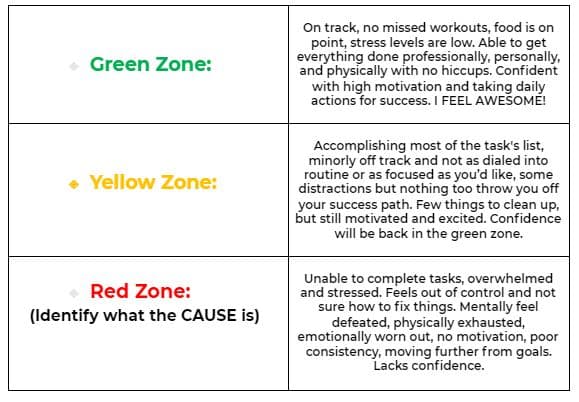
By identifying what kind of feelings and self-talk is consuming your clients/ athletes’ mental space will provide them an opportunity to develop awareness of what needs to be changed and will allow you as a coach to develop a strategy for change to occur and then put it into ACTION.
Strategy # 2: START, STOP, CONTINUE

Process over outcome. Too often the focus is on the result which can cause frustration, unmotivation, anxiety etc.
This strategy is a simple, yet effective strategy to further develop the PROCESS that brings greater awareness to BEHAVIORS and ACTIONS that may be holding your client or athlete back from reaching their highest potential and making the process of reaching their goals more difficult or frustrating.
Simply thinking on a smaller scale rather than a bigger one, which often can be overwhelming or seem impossible to accomplish will provide opportunities for a lot of SMALL VICTORIES.
By taking a step-by-step approach we can help clients identify more behaviors that need to be addressed one at a time that will ultimately add up to a very big win, which would be their desired outcome.
For this, I use the START, STOP, CONTINUE strategy. Ask your client “based on your goals, what do you need to START doing this week to get closer to achieving your goals? What do you need to STOP doing this week to get closer to reaching your goals? What do you need to CONTINUE to do to get closer to reaching your goals?”
There are three areas of opportunity with this strategy that will help further develop self-awareness, allow them to recognize small behaviors that need to be shifted, as well as small victories that help keep them motivated and working in the right direction.
You can employ this strategy week to week, or session to session further identifying areas that need to be developed or changed while adding to it each time.
Example:
I need to START walking 10-15minutes minimum a day.
I need to STOP eating out 4 times per week.
I need to CONTINUE to show up on time and prepare every training session with my coach.
I need to START focusing on the things I’m doing well.
I need to STOP blaming others for my shortcomings.
I need to CONTINUE to step out of my comfort zone so I can successfully achieve my goals.
Help your clients look at pieces to the puzzle and not just the entire picture. All the little pieces make the process and outcome THAT much more obtainable and hopefully more rewarding.
Strategy #3: (BFS) Body Language, Focus, Self-Talk

I use this strategy so my clients can identify for themselves how they act, think, and feel when they are at their best versus at what they feel is their worst.
The more self-awareness someone has the more they can correct any areas they may hold them back or cause them to make mental mistakes that will lead to poor physical performance.
I use a simple table for them to fill out, giving them the opportunity to make connections between mind and body at the highest and lowest points. Here is an example.
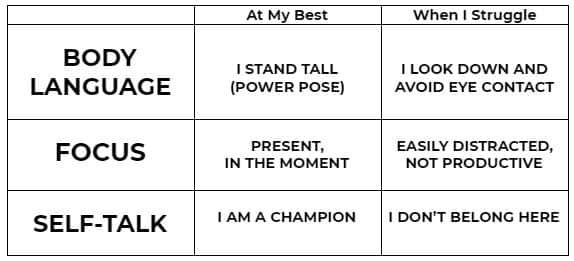
Having your clients fill in the blanks on their body language, internal dialogue, and focus will only contribute to better awareness and understanding of oneself furthering their chances of being successful in their efforts.
Strategy #4 FOCUS GRID
How often do you think about something other than what you’re doing or working on? During workouts do you get distracted, space off, too many thoughts going on?
Distractions are everyone from social media to chatty Cathy’s to random shenanigans which can make it hard to focus and be present. One of the biggest challenges in life is developing an appreciation for the value of the present moment.
Being able to effectively channel your ‘performance focus’ will not only help your productivity but can easily amplify your results. Too often I have written out an entire workout plan to only get through maybe half of it because of the lack of focus from said client.
That’s where ‘Concentration/focus Grids’ come in. May seem silly but can’t be any worse than already being distracted and getting your work finished.
Studies have proven an increased ability to remain focused through distractions and improve attention spans. Additionally, it can help develop a mental monitor that recognizes moments when you lose focus or get off track so you can quickly get into a better head space and back in “THE GAME” (sport or life).
Further, it will help build your capacity for self-regulation and your ability to stay calm and focused under stressful, high pressure situations.
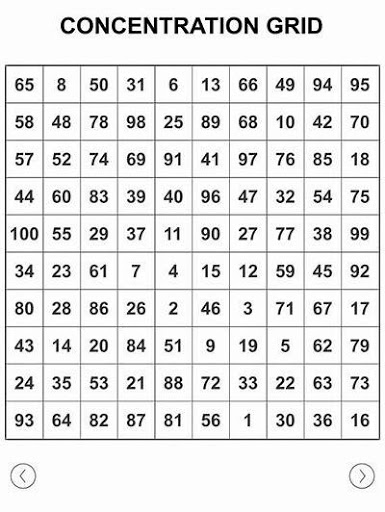
Here’s how: Depending on the how and where you are using this may be dependent on the size of your grid. I like to use the grids for the easily distracted between exercises as “rest breaks”, this at times will act as my “filler” to keep client engaged and present.
Typically, I start with a grid of 1-25 and may move to 1-50, or as high as a 1-100 grid. The goal of using the focus grid is to keep clients PRESENT instead of off-track conversations or environmental distractions.
You can easily laminate a grid, which I prefer to do, write it out on a piece of paper, or use a white board depending on what you have available.
You will set a timer and instruct the client to mark all the boxes in numeric order and track the time it takes them to finish. Once they have completed, they should be resuming back to their training session. No wasted time.
Pro-Tip: You may need to start in a quieter, less distracted area at first and progress to a “noisier” area to challenge their focus more. Like anything, doing this on a regular basis will allow for testing and re-testing of concentration abilities. It is important to remember to track the time it takes for completion to effectively gage progress over time, and remember like all things this takes time, practice, and patience.
Strategy # 5: Visualization/ IMAGERY

Mental Imagery/ mental rehearsal or, often referred to as visualization is the process of creating mental experiences that resembles the actual physical experience.
Scientific studies have shown the positive effects of creative visualization on health, such as immunity, stress, healing, and pain management. Science also shows that it improves many facets of life, from athletic ability to cognitive performance, to self- esteem, to goal achievement.
Mental imagery and visualization drills are a skill that when developed will allow you, your athlete/ client to improve the quality of their preparedness, enhance confidence, as well as decrease the time it takes for skill acquisition.
Additionally, by training/ coaching mediation practices, you will be able to quiet the mind and become relaxed enough to be more present and have greater focus on accomplishing essential tasks/skills.
Neuroscience has demonstrated that the brain can reproduce mental imagery from all the senses, including sights, sounds, tastes, smells, pressures, textures, temperatures, and movements.
SEE IT as vividly as you can
FEEL what it feels like
HEAR what it sounds like
One strategy to use is the 6-2-8 box breathing drill to help slow your roll (inhale for 6, hold for 2, exhale for 8- in through the nose out through the mouth) repeat this for 5-15 minutes. Don’t forget your patience here. Like all skills, time, effort, and PRACTICE is required to master this.
Build your confidence and take your performance whether in life or sport to the next level by adding in visualization drills to your training program. Everything starts in the mind first. By visualizing ourselves as successful, it pushes us to act accordingly to our visions as we know we’ve become more prepared and more likely will accomplish what we set our mind on. The power of visualization can be quite remarkable when done on a regular basis.
Are you familiar with Michael Phelps, U.S Olympic Swimmer or Adam Ondra who is one of the best rock climbers in the world? Both athletes express and demonstrate the value and effectiveness of visualization training that has led them to be some of the best, most successful athletes in the world. Check out the powerful clips below.

Personally, visualization drills have helped me overcome a lot of anxiety, stress, and fear leading up to a sports competition, a presentation, social interactions, and any day-to-day activities that may cause uneasiness or present a challenge. This is how I overcome fear, build confidence, and enhance my performance by being even more prepared from additional mental reps.
See it, believe it, achieve it.
Final Thought
As we’ve just passed the halfway mark of 2021, many of us are still dealing with the challenges faced from 2020 both on an individual level as well as collectively.
It has brought us pain, stress, loss, uncertainty, financial hardships and has led many to restless nights, garbage eating habits, lack of activity and movement, an abundance of stress, as well as poor mental and emotional health.
All of which can lead us down a dreary self-sabotaging journey with our thoughts. On the contrary, if we regularly program in mental training drills we can employ strategies that calm us, guide us, and help us achieve a flow state of self-discovery and awaken of the greater physical potential.
A strong set of mental performance skills will be the ultimate game changer for physical performance, mental enlightenment, and self-victory.
As fitness professionals, we have an incredible opportunity to provide more than just a prescribed exercise plan to our clients. We could enrich the lives of our athletes and clientele by simply utilizing tools (there are far more than I have offered here) to help expand the knowledge base and skills of those we serve.
I hope this article provided you with a little insight into the value of training mindset to improve your mental game during physical performance and day to day events, interactions, or obstacles you may run into. If we change our mindset, we can change our results.

